Sectoral Analysis of Energy Transition Paths and Greenhouse Gas Emissions
Abstract
1. Introduction
- A global, detailed overview of current GHG emission distribution change is provided and presented relative to recent research.
- A novel analytical technique is introduced, the percentile plot, to compare contributions to climate change.
- The sector breakdown of the data is considered to identify the driving sectors of climate change that need to be addressed.
- Improvement-related variables are defined subject to the European Green Deal-based utility function.
- The transition trajectories of the countries are determined by environmental Kuznets curves.
2. Methodology
2.1. Data Sources and Integration
2.2. Analysis of the Time Series of the Percentiles and Improvement Related Variables
2.3. Characterization of the Time Series of GHG Emissions
2.4. Kuznets Analysis
3. Results and Discussion
3.1. Analysis of the Global Trends in the Time Series of the Percentiles of GHG Emissions
3.2. Evaluation of the Consistency of the Sector-Wise Transitions
3.3. Country-Wise Comparison Based on the Trends on the Improvement-Related Variables
3.4. Kuznets Analysis
4. Conclusions
Author Contributions
Funding
Institutional Review Board Statement
Informed Consent Statement
Data Availability Statement
Conflicts of Interest
References
- Stocker, T. Climate Change 2013: The Physical Science Basis: Working Group I Contribution to the Fifth Assessment Report of the Intergovernmental Panel on Climate Change; Cambridge University Press: Cambridge, UK, 2014. [Google Scholar]
- Dale, S. BP Statistical Review of World Energy 2021; BP Plc: London, UK, 2021. [Google Scholar]
- Desa, U. Transforming Our World: The 2030 Agenda for Sustainable Development; United Nations: New York, NY, USA, 2016.
- Rogelj, J.; Den Elzen, M.; Höhne, N.; Fransen, T.; Fekete, H.; Winkler, H.; Schaeffer, R.; Sha, F.; Riahi, K.; Meinshausen, M. Paris Agreement climate proposals need a boost to keep warming well below 2 C. Nature 2016, 534, 631–639. [Google Scholar] [CrossRef] [PubMed]
- Tian, J.; Yu, L.; Xue, R.; Zhuang, S.; Shan, Y. Global low-carbon energy transition in the post-COVID-19 era. Appl. Energy 2022, 307, 118205. [Google Scholar] [CrossRef] [PubMed]
- Bogdanov, D.; Ram, M.; Aghahosseini, A.; Gulagi, A.; Oyewo, A.S.; Child, M.; Caldera, U.; Sadovskaia, K.; Farfan, J.; Barbosa, L.D.S.N.S.; et al. Low-cost renewable electricity as the key driver of the global energy transition towards sustainability. Energy 2021, 227, 120467. [Google Scholar] [CrossRef]
- Foley, A.; Smyth, B.M.; Pukšec, T.; Markovska, N.; Duić, N. A review of developments in technologies and research that have had a direct measurable impact on sustainability considering the Paris agreement on climate change. Renew. Sustain. Energy Rev. 2017, 68, 835–839. [Google Scholar] [CrossRef]
- Santika, W.G.; Anisuzzaman, M.; Bahri, P.A.; Shafiullah, G.; Rupf, G.V.; Urmee, T. From goals to joules: A quantitative approach of interlinkages between energy and the Sustainable Development Goals. Energy Res. Soc. Sci. 2019, 50, 201–214. [Google Scholar] [CrossRef]
- Grubler, A.; Wilson, C.; Bento, N.; Boza-Kiss, B.; Krey, V.; McCollum, D.L.; Rao, N.D.; Riahi, K.; Rogelj, J.; De Stercke, S.; et al. A low energy demand scenario for meeting the 1.5 C target and sustainable development goals without negative emission technologies. Nat. Energy 2018, 3, 515–527. [Google Scholar] [CrossRef]
- Sikora, A. European Green Deal–legal and financial challenges of the climate change. In Proceedings of the Era Forum; Springer: Berlin/Heidelberg, Germany, 2021; Volume 21, pp. 681–697. [Google Scholar]
- Tao, R.; Umar, M.; Naseer, A.; Razi, U. The dynamic effect of eco-innovation and environmental taxes on carbon neutrality target in emerging seven (E7) economies. J. Environ. Manag. 2021, 299, 113525. [Google Scholar] [CrossRef]
- Lovell, H.; Liverman, D. Understanding carbon offset technologies. New Political Econ. 2010, 15, 255–273. [Google Scholar] [CrossRef]
- Wilberforce, T.; Olabi, A.; Sayed, E.T.; Elsaid, K.; Abdelkareem, M.A. Progress in carbon capture technologies. Sci. Total Environ. 2021, 761, 143203. [Google Scholar] [CrossRef]
- Ashley, M.J.; Johnson, M.S. Establishing a secure, transparent, and autonomous blockchain of custody for renewable energy credits and carbon credits. IEEE Eng. Manag. Rev. 2018, 46, 100–102. [Google Scholar] [CrossRef]
- Chang, M.; Thellufsen, J.Z.; Zakeri, B.; Pickering, B.; Pfenninger, S.; Lund, H.; Østergaard, P.A. Trends in tools and approaches for modelling the energy transition. Appl. Energy 2021, 290, 116731. [Google Scholar] [CrossRef]
- Dolge, K.; Blumberga, D. Economic growth in contrast to GHG emission reduction measures in Green Deal context. Ecol. Indic. 2021, 130, 108153. [Google Scholar] [CrossRef]
- Hainsch, K.; Löffler, K.; Burandt, T.; Auer, H.; del Granado, P.C.; Pisciella, P.; Zwickl-Bernhard, S. Energy transition scenarios: What policies, societal attitudes, and technology developments will realize the EU Green Deal? Energy 2022, 239, 122067. [Google Scholar] [CrossRef]
- Chen, X.; Yang, F.; Zhang, S.; Zakeri, B.; Chen, X.; Liu, C.; Hou, F. Regional emission pathways, energy transition paths and cost analysis under various effort-sharing approaches for meeting Paris Agreement goals. Energy 2021, 232, 121024. [Google Scholar] [CrossRef]
- Hojnik, J.; Ruzzier, M. What drives eco-innovation? A review of an emerging literature. Environ. Innov. Soc. Transitions 2016, 19, 31–41. [Google Scholar] [CrossRef]
- Althor, G.; Watson, J.E.; Fuller, R.A. Global mismatch between greenhouse gas emissions and the burden of climate change. Sci. Rep. 2016, 6, 20281. [Google Scholar] [CrossRef]
- Squalli, J. Disentangling the relationship between immigration and environmental emissions. Popul. Environ. 2021, 43, 1–21. [Google Scholar] [CrossRef]
- Gillenwater, M. Forgotten carbon: Indirect CO2 in greenhouse gas emission inventories. Environ. Sci. Policy 2008, 11, 195–203. [Google Scholar] [CrossRef]
- Kumar, A.; Singh, P.; Raizada, P.; Hussain, C.M. Impact of COVID-19 on greenhouse gases emissions: A critical review. Sci. Total Environ. 2022, 806, 150349. [Google Scholar] [CrossRef]
- Twine, R. Emissions from Animal Agriculture—16.5% Is the New Minimum Figure. Sustainability 2021, 13, 6276. [Google Scholar] [CrossRef]
- Baloch, M.A.; Danish; Qiu, Y. Does energy innovation play a role in achieving sustainable development goals in BRICS countries? Environ. Technol. 2021, 43, 2290–2299. [Google Scholar] [CrossRef] [PubMed]
- Hamid, I.; Alam, M.S.; Kanwal, A.; Jena, P.K.; Murshed, M.; Alam, R. Decarbonization pathways: The roles of foreign direct investments, governance, democracy, economic growth, and renewable energy transition. Environ. Sci. Pollut. Res. 2022, 29, 49816–49831. [Google Scholar] [CrossRef] [PubMed]
- Ćetković, J.; Lakić, S.; Živković, A.; Žarković, M.; Vujadinović, R. Economic analysis of measures for GHG emission reduction. Sustainability 2021, 13, 1712. [Google Scholar] [CrossRef]
- Gençer, E.; Torkamani, S.; Miller, I.; Wu, T.W.; O’Sullivan, F. Sustainable energy system analysis modeling environment: Analyzing life cycle emissions of the energy transition. Appl. Energy 2020, 277, 115550. [Google Scholar] [CrossRef]
- Wardekker, A.; Lorenz, S. The visual framing of climate change impacts and adaptation in the IPCC assessment reports. Clim. Chang. 2019, 156, 273–292. [Google Scholar] [CrossRef]
- Mukhopadhyay, U.; Pani, R. Emission and sectoral energy intensity: A variance decomposition analysis. Manag. Environ. Qual. Int. J. 2022, 33, 955–974. [Google Scholar] [CrossRef]
- Climate Watch, GHG Emissions Excluding Land-Use Change and Forestry, CAIT Data. Available online: https://www.climatewatchdata.org/data-explorer/historical-emissions?historical-emissions-data-sources=cait&historical-emissions-gases=&historical-emissions-regions=&historical-emissions-sectors=&page=1 (accessed on 9 August 2021).
- Phiri, A. Economic growth, Environmental degradation and business cycles in Eswatini. Bus. Econ. Horizons 2019, 15, 490–498. [Google Scholar]
- Borozan, D. Revealing the complexity in the environmental Kuznets curve set in a European multivariate framework. Environ. Dev. Sustain. 2021, 24, 9165–9184. [Google Scholar] [CrossRef]
- Grossman, G.M.; Krueger, A.B. Economic growth and the environment. Q. J. Econ. 1995, 110, 353–377. [Google Scholar] [CrossRef]
- Agency, E.P. Inventory of U.S. Greenhouse Gas Emissions and Sinks: 1990–2019; Technical Report; United States Environmental Protection Agency: Washington, DC, USA, 2021.
- GDP World Bank Data. Available online: https://www.kaggle.com/ibrahimmukherjee/\gdp-world-bank-data (accessed on 13 July 2021).
- Olivier, J.; Peters, J. Trends in Global CO2 and Total Greenhouse Gas Emissions; PBL Netherlands Environmental Assessment Agency: Hague, The Nethwelands, 2020. [Google Scholar]
- Kleinbaum, D.G.; Klein, M. Survival Analysis; Springer: New York, NY, USA, 2010; Volume 3. [Google Scholar]
- Gibbons, J.D.; Chakraborti, S. Nonparametric Statistical Inference; CRC Press: Boca Raton, FL, USA, 2014. [Google Scholar]
- Chen, Z. A note on the runs test. Model Assist. Stat. Appl. 2010, 5, 73–77. [Google Scholar] [CrossRef]
- Leybourne, S.J.; HcCabe, B. Modified stationarity tests with data-dependent model-selection rules. J. Bus. Econ. Stat. 1999, 17, 264–270. [Google Scholar]
- Stern, D.I. The environmental Kuznets curve. In Oxford Research Encyclopedia of Environmental Science; Oxford University Press: Oxford, UK, 2017. [Google Scholar]
- Shahbaz, M.; Sinha, A. Environmental Kuznets curve for CO2 emissions: A literature survey. J. Econ. Stud. 2019, 46, 106–168. [Google Scholar] [CrossRef]
- Destek, M.A.; Ulucak, R.; Dogan, E. Analyzing the environmental Kuznets curve for the EU countries: The role of ecological footprint. Environ. Sci. Pollut. Res. 2018, 25, 29387–29396. [Google Scholar] [CrossRef]
- Wang, Q.; Wang, X.; Li, R. Does urbanization redefine the environmental Kuznets curve? An empirical analysis of 134 Countries. Sustain. Cities Soc. 2022, 76, 103382. [Google Scholar] [CrossRef]
- Katsoulakos, N.; Misthos, L.M.; Doulos, I.G.; Kotsios, V. Environment and Development. In Environment and Development; Elsevier: Amsterdam, The Netherlands, 2016; pp. 499–569. [Google Scholar]
- Sarkodie, S.A.; Ozturk, I. Investigating the environmental Kuznets curve hypothesis in Kenya: A multivariate analysis. Renew. Sustain. Energy Rev. 2020, 117, 109481. [Google Scholar] [CrossRef]
- Kaika, D.; Zervas, E. The Environmental Kuznets Curve (EKC) theory—Part A: Concept, causes and the CO2 emissions case. Energy Policy 2013, 62, 1392–1402. [Google Scholar] [CrossRef]
- Churchill, S.A.; Inekwe, J.; Ivanovski, K.; Smyth, R. The environmental Kuznets curve in the OECD: 1870–2014. Energy Econ. 2018, 75, 389–399. [Google Scholar] [CrossRef]
- Boubellouta, B.; Kusch-Brandt, S. Testing the environmental Kuznets Curve hypothesis for E-waste in the EU28+ 2 countries. J. Clean. Prod. 2020, 277, 123371. [Google Scholar] [CrossRef]
- Yao, S.; Zhang, S.; Zhang, X. Renewable energy, carbon emission and economic growth: A revised environmental Kuznets Curve perspective. J. Clean. Prod. 2019, 235, 1338–1352. [Google Scholar] [CrossRef]
- Olhoff, A.; Christensen, J.M. Emissions Gap Report 2020; UNEP DTU Partnership; 2020; Available online: https://www.unep.org/emissions-gap-report-2020 (accessed on 24 July 2022).
- Di Giulio, A.; Fuchs, D. Sustainable consumption corridors: Concept, objections, and responses. GAIA-Ecol. Perspect. Sci. Soc. 2014, 23, 184–192. [Google Scholar] [CrossRef]
- Saujot, M.; Le Gallic, T.; Waisman, H. Lifestyle changes in mitigation pathways: Policy and scientific insights. Environ. Res. Lett. 2020, 16, 015005. [Google Scholar] [CrossRef]
- Fanning, A.L.; O’Neill, D.W.; Büchs, M. Provisioning systems for a good life within planetary boundaries. Glob. Environ. Chang. 2020, 64, 102135. [Google Scholar] [CrossRef]
- Qatar, G. Qatar national vision 2030. In Doha, General Secretariat for Development; 2008. Available online: https://www.psa.gov.qa/en/qnv1/pages/default.aspx (accessed on 24 July 2022).
- Government Offices of Sweden. Sweden’s Long-Term Strategy for Reducing Greenhouse Gas Emissions; 2020. Available online: https://unfccc.int/documents/267243 (accessed on 24 July 2022).
- Le Quéré, C.; Korsbakken, J.I.; Wilson, C.; Tosun, J.; Andrew, R.; Andres, R.J.; Canadell, J.G.; Jordan, A.; Peters, G.P.; van Vuuren, D.P. Drivers of declining CO2 emissions in 18 developed economies. Nat. Clim. Chang. 2019, 9, 213–217. [Google Scholar] [CrossRef]
- Lamb, W.F.; Wiedmann, T.; Pongratz, J.; Andrew, R.; Crippa, M.; Olivier, J.G.; Wiedenhofer, D.; Mattioli, G.; Al Khourdajie, A.; House, J.; et al. A review of trends and drivers of greenhouse gas emissions by sector from 1990 to 2018. Environ. Res. Lett. 2021, 16, 073005. [Google Scholar] [CrossRef]
- Duić, N.; Krajačić, G. Decarbonisation of Heating—Towards 2050. In Solar Energy Conversion in Communities; Springer: Cham, Germany, 2020; pp. 177–178. [Google Scholar]
- Dobravec, V.; Matak, N.; Sakulin, C.; Krajačić, G. Multilevel governance energy planning and policy: A view on local energy initiatives. Energy, Sustain. Soc. 2021, 11, 2. [Google Scholar] [CrossRef]
- Yuan, M.; Thellufsen, J.Z.; Lund, H.; Liang, Y. The electrification of transportation in energy transition. Energy 2021, 236, 121564. [Google Scholar] [CrossRef]
- Mikulčić, H.; Skov, I.R.; Dominković, D.F.; Alwi, S.R.W.; Manan, Z.A.; Tan, R.; Duić, N.; Mohamad, S.N.H.; Wang, X. Flexible Carbon Capture and Utilization technologies in future energy systems and the utilization pathways of captured CO2. Renew. Sustain. Energy Rev. 2019, 114, 109338. [Google Scholar] [CrossRef]
- Bombelli, A.; Di Paola, A.; Chiriacò, M.V.; Perugini, L.; Castaldi, S.; Valentini, R. Climate change, sustainable agriculture and food systems: The world after the Paris agreement. In Achieving the Sustainable Development Goals Through Sustainable Food Systems; Springer: Cham, Germany, 2019; pp. 25–34. [Google Scholar]
- Svensson, J.; Waisman, H.; Vogt-Schilb, A.; Bataille, C.; Aubert, P.M.; Jaramilo-Gil, M.; Angulo-Paniagua, J.; Arguello, R.; Bravo, G.; Buira, D.; et al. A low GHG development pathway design framework for agriculture, forestry and land use. Energy Strategy Rev. 2021, 37, 100683. [Google Scholar] [CrossRef]
- Davis, S.J.; Lewis, N.S.; Shaner, M.; Aggarwal, S.; Arent, D.; Azevedo, I.L.; Benson, S.M.; Bradley, T.; Brouwer, J.; Chiang, Y.M.; et al. Net-zero emissions energy systems. Science 2018, 360, eaas9793. [Google Scholar] [CrossRef]
- Rissman, J.; Bataille, C.; Masanet, E.; Aden, N.; Morrow III, W.R.; Zhou, N.; Elliott, N.; Dell, R.; Heeren, N.; Huckestein, B.; et al. Technologies and policies to decarbonize global industry: Review and assessment of mitigation drivers through 2070. Appl. Energy 2020, 266, 114848. [Google Scholar] [CrossRef]
- Magazzino, C.; Mele, M.; Schneider, N.; Sarkodie, S.A. Waste generation, wealth and GHG emissions from the waste sector: Is Denmark on the path towards circular economy? Sci. Total Environ. 2021, 755, 142510. [Google Scholar] [CrossRef] [PubMed]
- Joung, T.H.; Kang, S.G.; Lee, J.K.; Ahn, J. The IMO initial strategy for reducing Greenhouse Gas (GHG) emissions, and its follow-up actions towards 2050. J. Int. Marit. Safety, Environ. Aff. Shipp. 2020, 4, 1–7. [Google Scholar] [CrossRef]
- Englert, D.; Losos, A.; Raucci, C.; Smith, T. The Potential of Zero-Carbon Bunker Fuels in Developing Countries; International Bank for Reconstruction and Development/The World Bank: Washington, DC, USA, 2021. [Google Scholar]
- Defeuilley, C. Energy transition and the future(s) of the electricity sector. Util. Policy 2019, 57, 97–105. [Google Scholar] [CrossRef]
- Sayed-Mouchaweh, M. Artificial Intelligence Techniques for a Scalable Energy Transition: Advanced Methods, Digital Technologies, Decision Support Tools, and Applications; Springer: Cham, Switherlands, 2020. [Google Scholar]
- Hanna, R.; Victor, D.G. Marking the decarbonization revolutions. Nat. Energy 2021, 6, 568–571. [Google Scholar] [CrossRef]
- Sroufe, R.; Watts, A. Pathways to Agricultural Decarbonization: Climate Change Obstacles and Opportunities in the US. Resour. Conserv. Recycl. 2022, 182, 106276. [Google Scholar] [CrossRef]
- Aghajanzadeh, A.; Therkelsen, P. Agricultural demand response for decarbonizing the electricity grid. J. Clean. Prod. 2019, 220, 827–835. [Google Scholar] [CrossRef]
- Sovacool, B.K.; Bazilian, M.; Griffiths, S.; Kim, J.; Foley, A.; Rooney, D. Decarbonizing the food and beverages industry: A critical and systematic review of developments, sociotechnical systems and policy options. Renew. Sustain. Energy Rev. 2021, 143, 110856. [Google Scholar] [CrossRef]
- Camarasa, C.; Mata, É.; Navarro, J.P.J.; Reyna, J.; Bezerra, P.; Angelkorte, G.B.; Feng, W.; Filippidou, F.; Forthuber, S.; Harris, C.; et al. A global comparison of building decarbonization scenarios by 2050 towards 1.5–2 °C targets. Nat. Commun. 2022, 13, 3077. [Google Scholar] [CrossRef]
- Ma, M.; Ma, X.; Cai, W.; Cai, W. Carbon-dioxide mitigation in the residential building sector: A household scale-based assessment. Energy Convers. Manag. 2019, 198, 111915. [Google Scholar] [CrossRef]
- Murakami, S.; Levine, M.D.; Yoshino, H.; Inoue, T.; Ikaga, T.; Shimoda, Y.; Miura, S.; Sera, T.; Nishio, M.; Sakamoto, Y.; et al. Overview of energy consumption and GHG mitigation technologies in the building sector of Japan. Energy Effic. 2009, 2, 179–194. [Google Scholar] [CrossRef]
- Halim, R.A.; Smith, T.; Englert, D.P. Understanding the Economic Impacts of Greenhouse Gas Mitigation Policies on Shipping: What Is the State of the Art of Current Modeling Approaches? In World Bank Policy Research Working Paper; World Bank Group: Washington, DC, USA, 2019. [Google Scholar]
- Monna, S.; Abdallah, R.; Juaidi, A.; Albatayneh, A.; Zapata-Sierra, A.J.; Manzano-Agugliaro, F. Potential Electricity Production by Installing Photovoltaic Systems on the Rooftops of Residential Buildings in Jordan: An Approach to Climate Change Mitigation. Energies 2022, 15, 496. [Google Scholar] [CrossRef]
- Gupta, A.; Davis, M.; Kumar, A. An integrated assessment framework for the decarbonization of the electricity generation sector. Appl. Energy 2021, 288, 116634. [Google Scholar] [CrossRef]
- Sebestyén, V. Renewable and Sustainable Energy Reviews: Environmental impact networks of renewable energy power plants. Renew. Sustain. Energy Rev. 2021, 151, 111626. [Google Scholar] [CrossRef]
- Munsif, R.; Zubair, M.; Aziz, A.; Zafar, M.N. Industrial air emission pollution: Potential sources and sustainable mitigation. In Environmental Emissions; IntechOpen: London, UK, 2021. [Google Scholar]
- Mi, Z.; Sun, X. Provinces with transitions in industrial structure and energy mix performed best in climate change mitigation in China. Commun. Earth Environ. 2021, 2, 182. [Google Scholar] [CrossRef]
- Milovanoff, A.; Minet, L.; Cheah, L.; Posen, I.D.; MacLean, H.L.; Balasubramanian, R. Greenhouse gas emission mitigation pathways for urban passenger land transport under ambitious climate targets. Environ. Sci. Technol. 2021, 55, 8236–8246. [Google Scholar] [CrossRef]
- Zheng, X.; Streimikiene, D.; Balezentis, T.; Mardani, A.; Cavallaro, F.; Liao, H. A review of greenhouse gas emission profiles, dynamics, and climate change mitigation efforts across the key climate change players. J. Clean. Prod. 2019, 234, 1113–1133. [Google Scholar] [CrossRef]
- Tutak, M.; Brodny, J.; Bindzár, P. Assessing the Level of Energy and Climate Sustainability in the European Union Countries in the Context of the European Green Deal Strategy and Agenda 2030. Energies 2021, 14, 1767. [Google Scholar] [CrossRef]
- Lamb, W.F.; Grubb, M.; Diluiso, F.; Minx, J.C. Countries with sustained greenhouse gas emissions reductions: An analysis of trends and progress by sector. Clim. Policy 2022, 22, 1–17. [Google Scholar] [CrossRef]
- Stern, D.I. The environmental Kuznets curve after 25 years. J. Bioecon. 2017, 19, 7–28. [Google Scholar] [CrossRef]
- Sarkodie, S.A.; Strezov, V. A review on environmental Kuznets curve hypothesis using bibliometric and meta-analysis. Sci. Total Environ. 2019, 649, 128–145. [Google Scholar] [CrossRef]
- Agency, E.E. Why Did Greenhouse Gas Emissions Decrease in the EU between 1990 and 2012? European Environment Agency: Copenhagen, Denmark, 2014.
- Sarkodie, S.A.; Strezov, V. Effect of foreign direct investments, economic development and energy consumption on greenhouse gas emissions in developing countries. Sci. Total Environ. 2019, 646, 862–871. [Google Scholar] [CrossRef] [PubMed]
- Sarkodie, S.A.; Strezov, V. Empirical study of the environmental Kuznets curve and environmental sustainability curve hypothesis for Australia, China, Ghana and USA. J. Clean. Prod. 2018, 201, 98–110. [Google Scholar] [CrossRef]
- Song, J.; Yang, W.; Wang, S.; Higano, Y.; Fang, K. Exploring potential pathways towards fossil energy-related GHG emission peak prior to 2030 for China: An integrated input-output simulation model. J. Clean. Prod. 2018, 178, 688–702. [Google Scholar] [CrossRef]
- Bulut, U. Testing environmental Kuznets curve for the USA under a regime shift: The role of renewable energy. Environ. Sci. Pollut. Res. 2019, 26, 14562–14569. [Google Scholar] [CrossRef]
- Urban, F.; Nordensvärd, J. Low carbon energy transitions in the Nordic countries: Evidence from the environmental Kuznets curve. Energies 2018, 11, 2209. [Google Scholar] [CrossRef]
- Qatar—International Energy Data and Analysis; U.S. Energy Information Administration: Washington, DC, USA, 2015.
- Salahuddin, M.; Gow, J. Effects of energy consumption and economic growth on environmental quality: Evidence from Qatar. Environ. Sci. Pollut. Res. 2019, 26, 18124–18142. [Google Scholar] [CrossRef]
- Tan, T.; Al-Khalaqi, A.; Al-Khulaifi, N. Qatar national vision 2030. Sustain. Dev. Apprais. Gulf Reg. 2014, 19, 65. [Google Scholar]
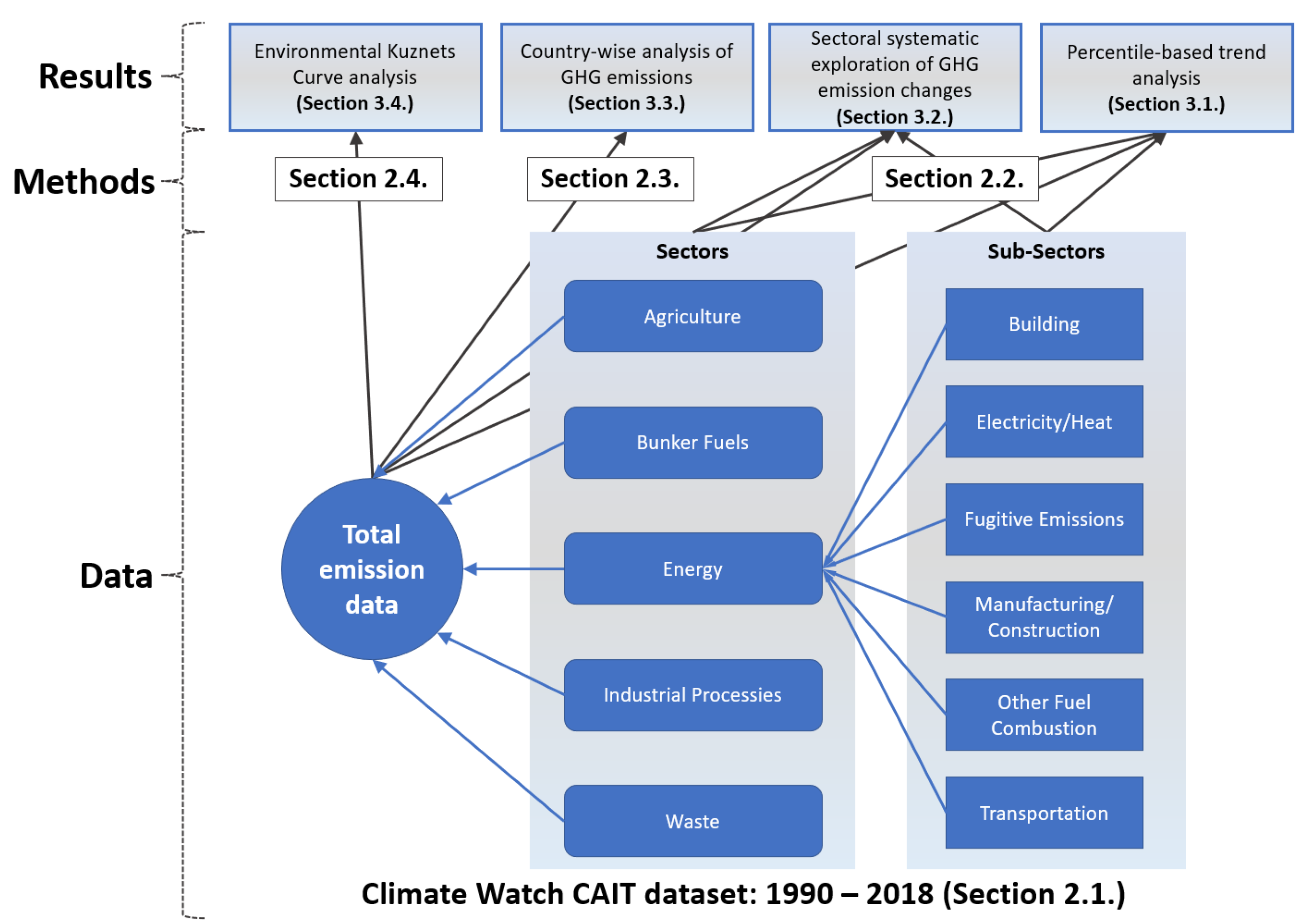
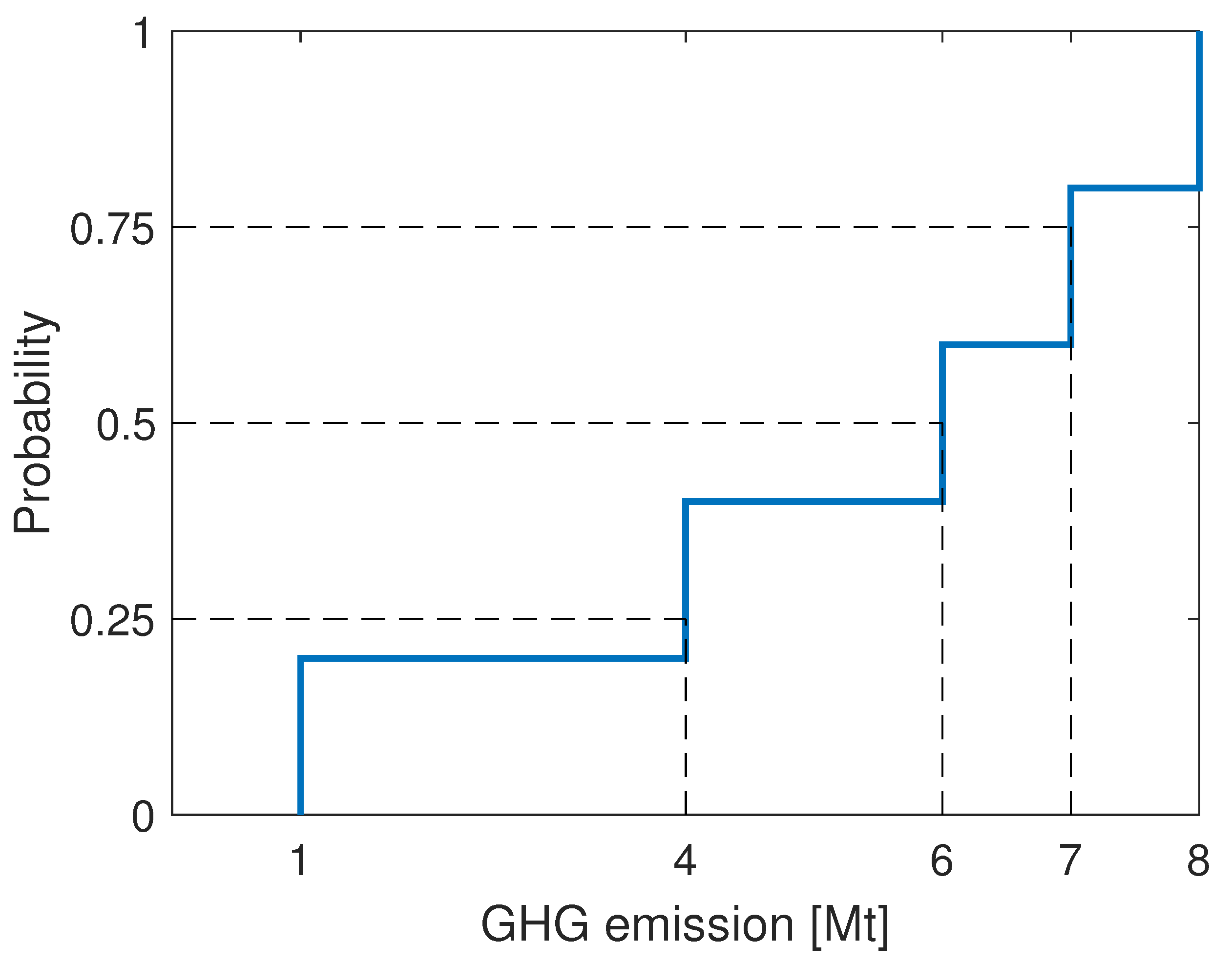
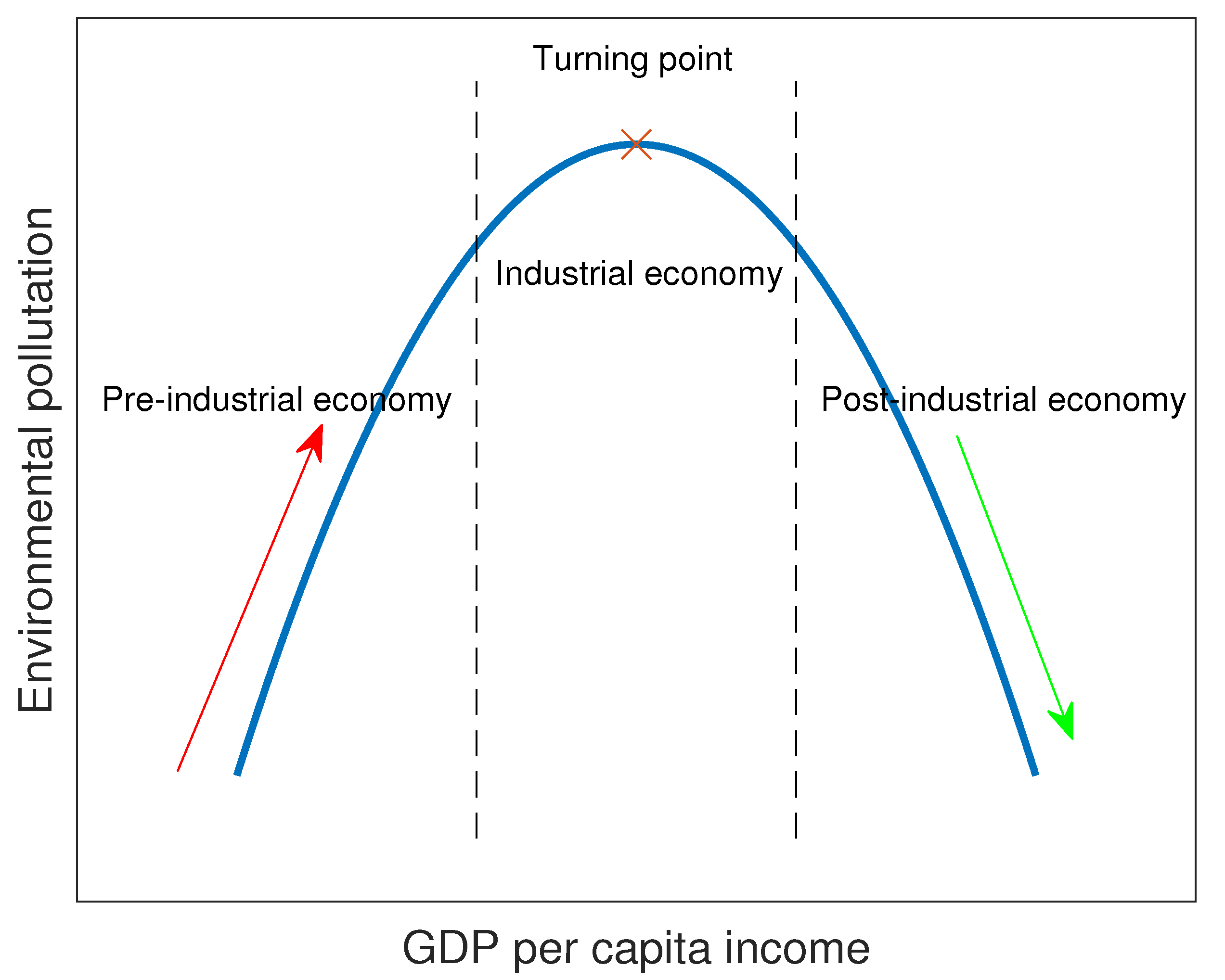
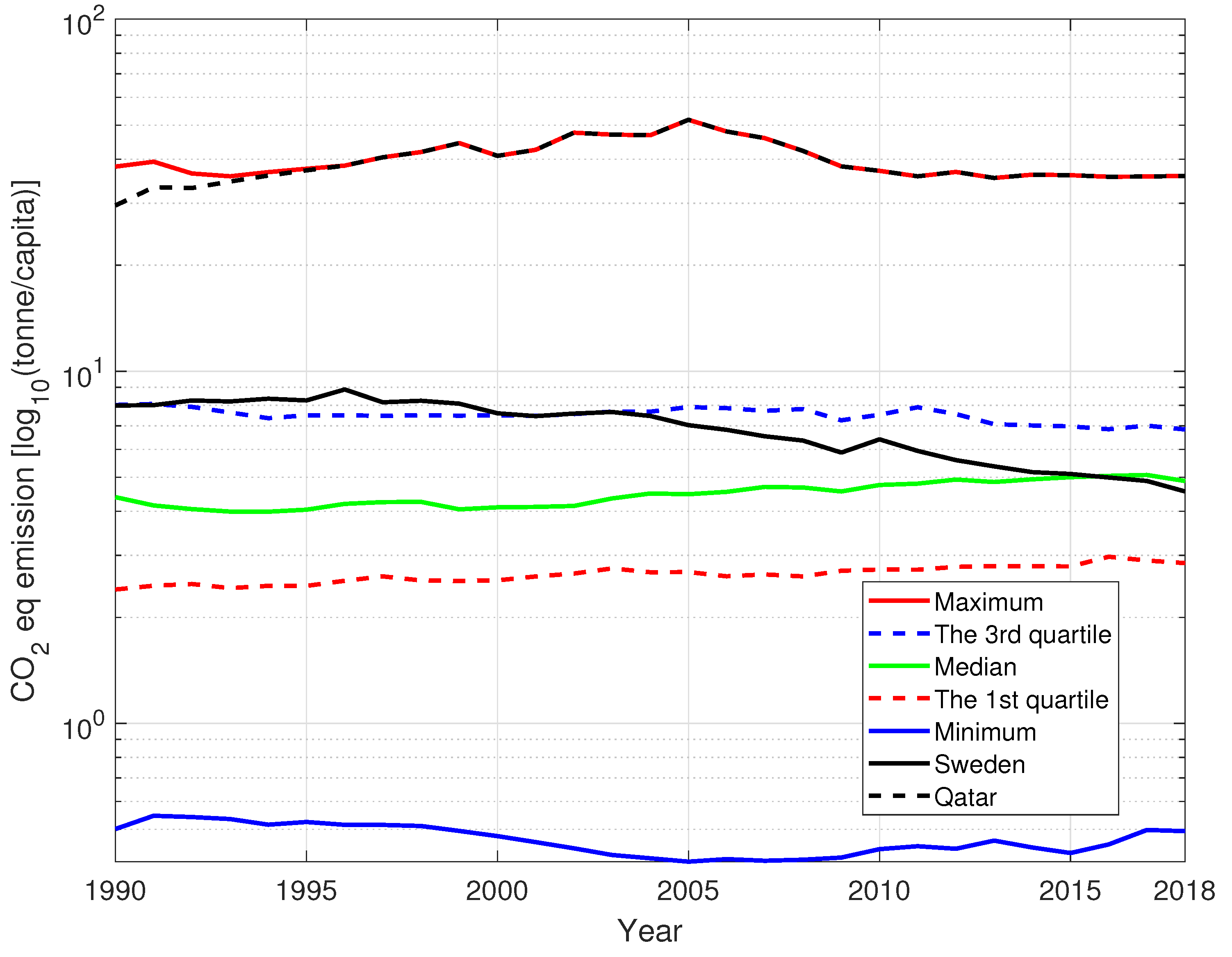
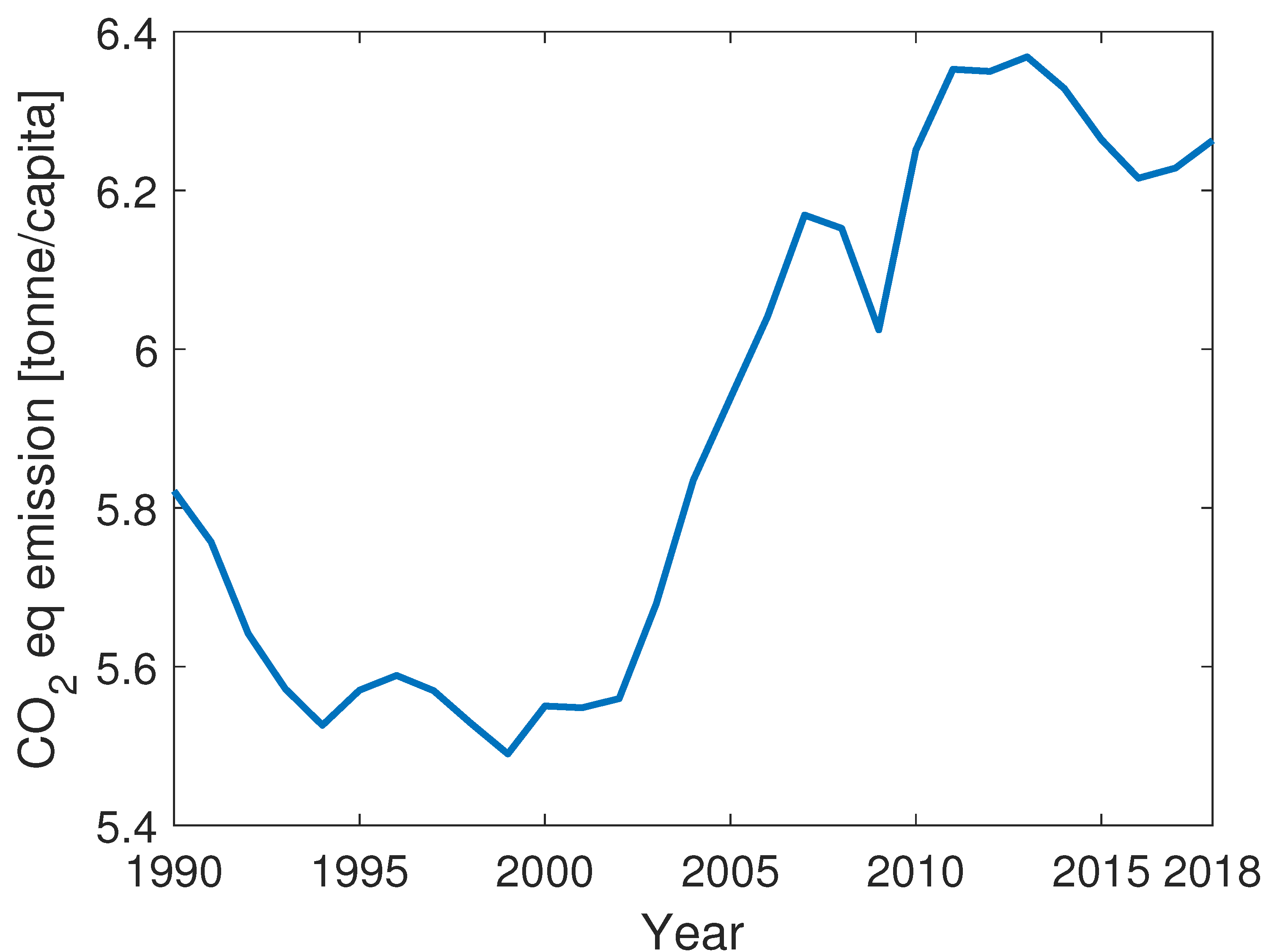
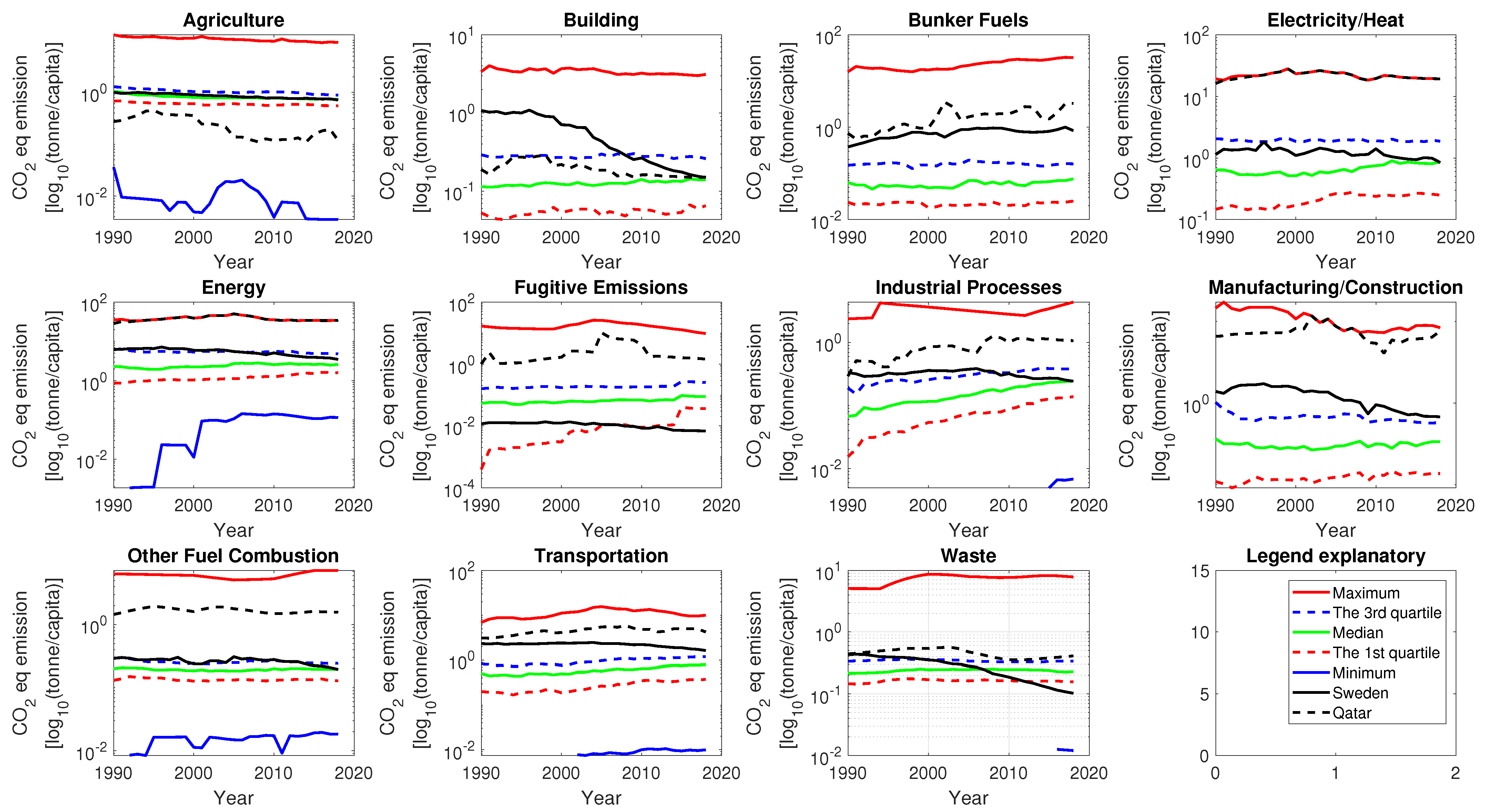
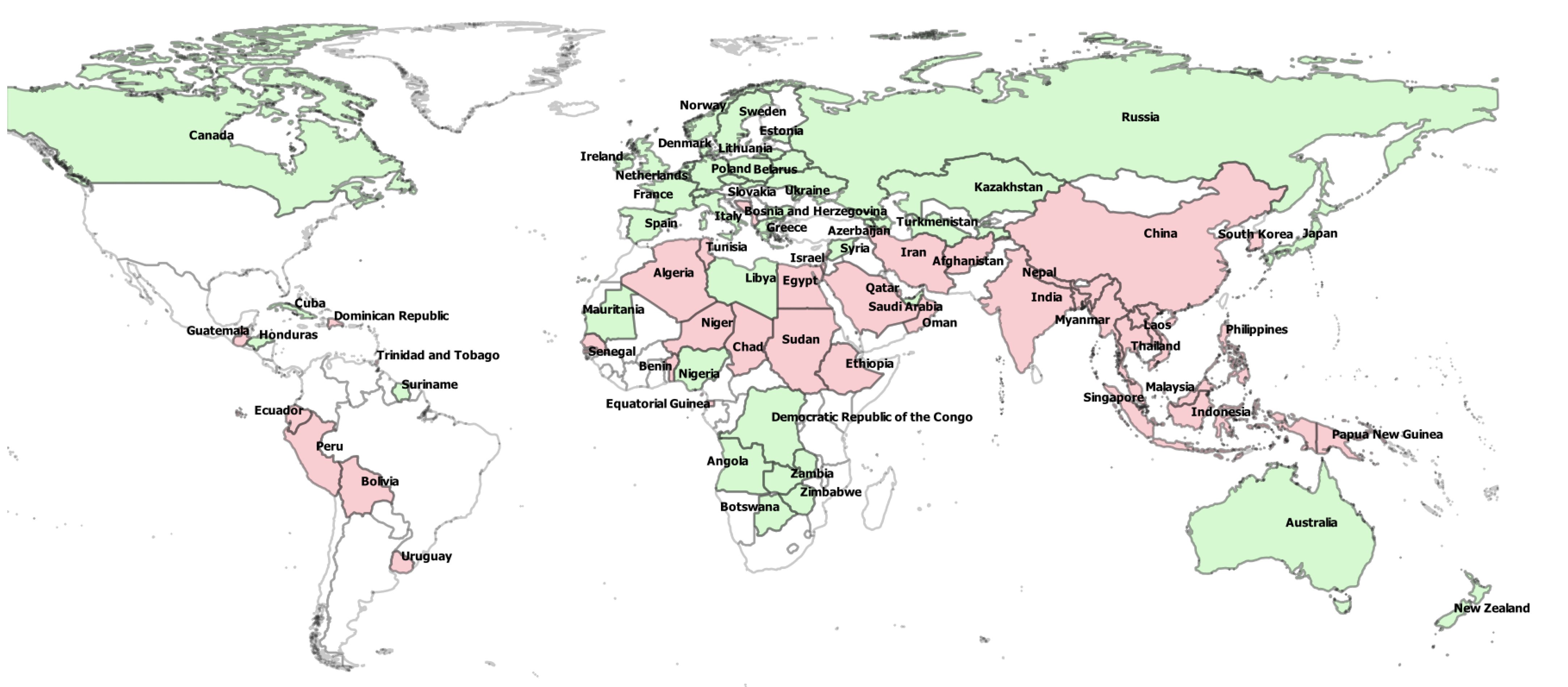
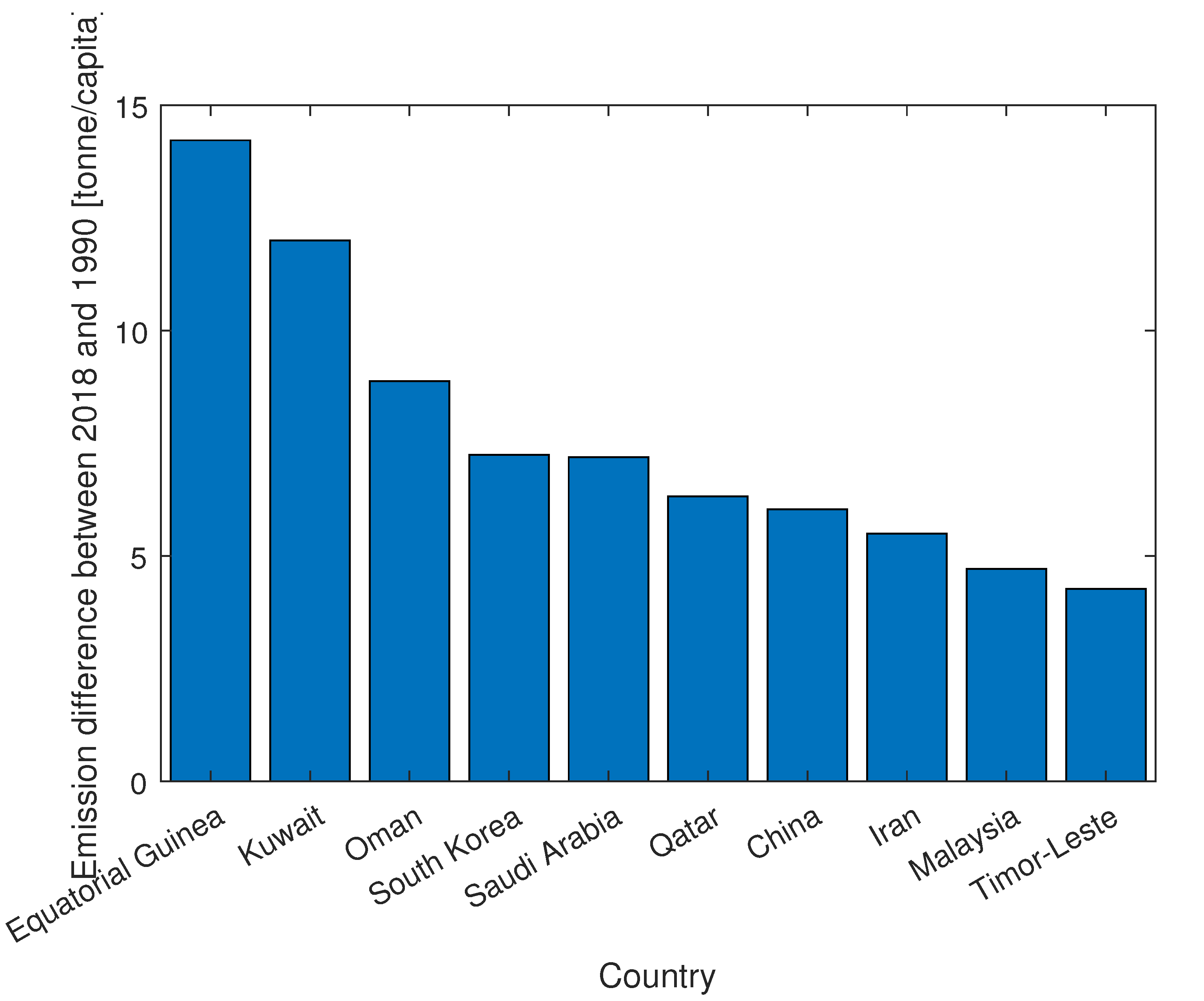

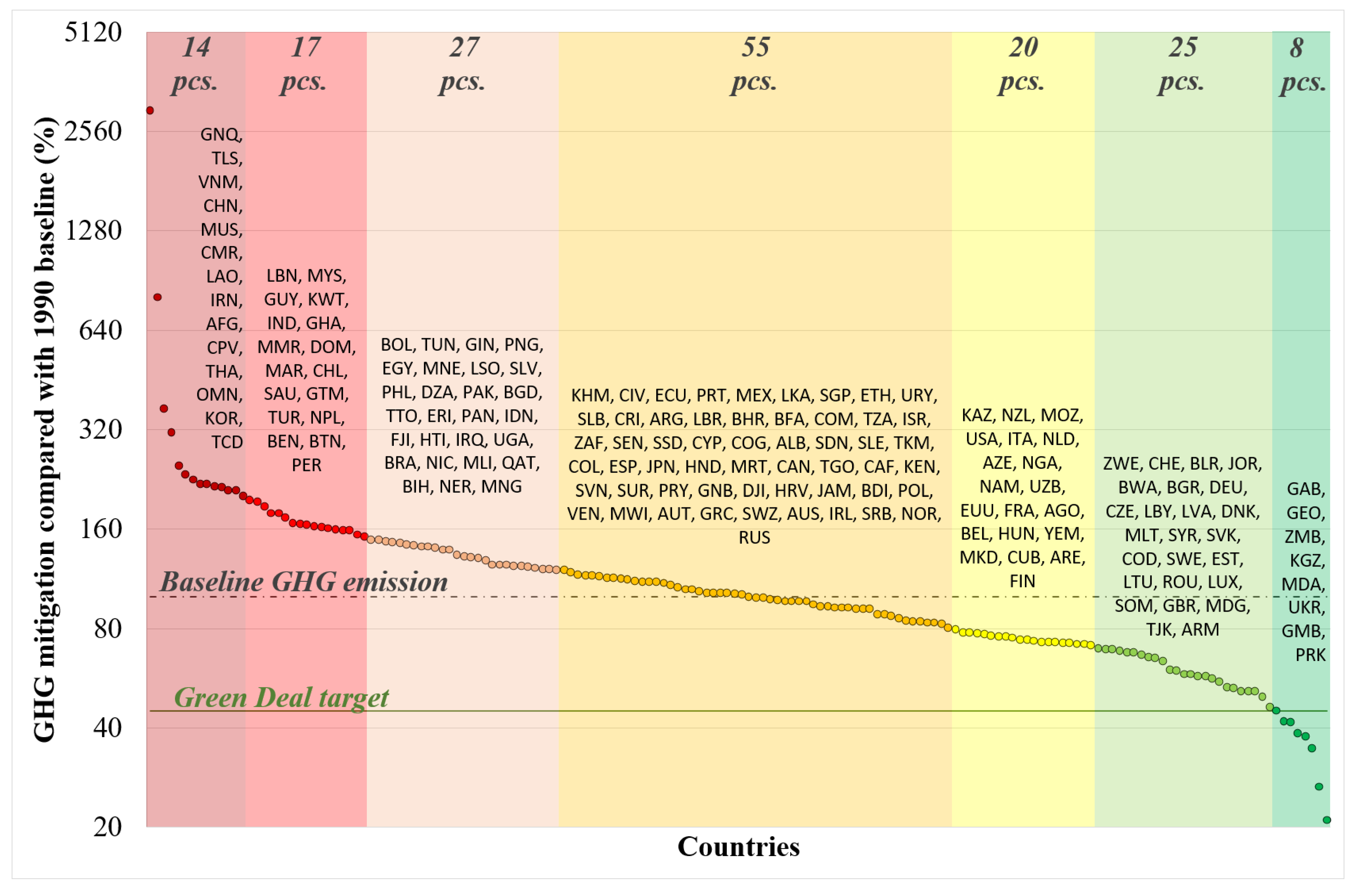

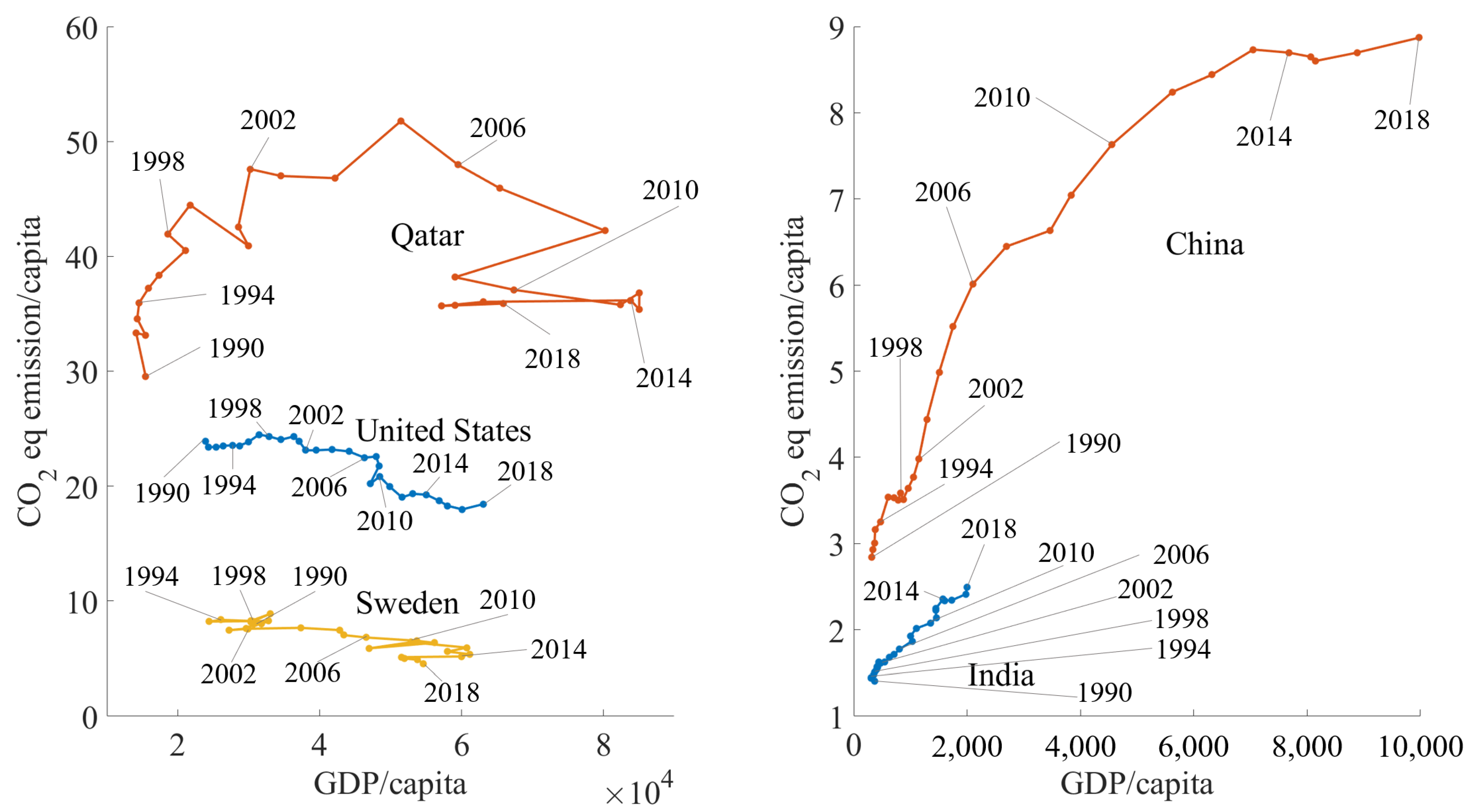
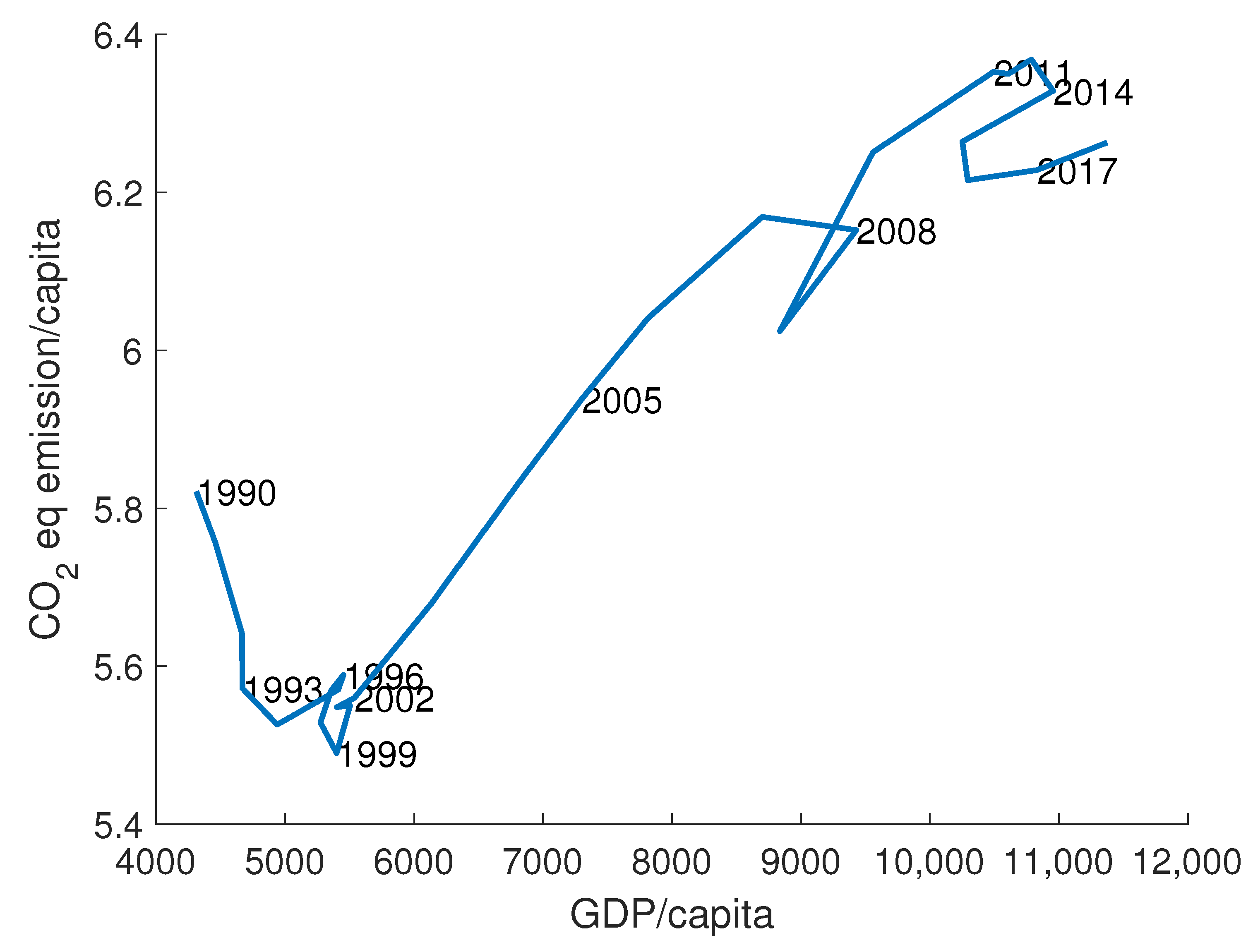
| Sector | Random | Not Random | Not Stationary | Stationary |
|---|---|---|---|---|
| Agriculture | 7 | 159 | 83 | 83 |
| Building | 16 | 150 | 100 | 66 |
| Bunker Fuels | 18 | 148 | 103 | 63 |
| Electricity/Heat | 13 | 153 | 83 | 83 |
| Energy | 2 | 164 | 56 | 110 |
| Fugitive Emissions | 35 | 131 | 82 | 84 |
| Industrial Processes | 2 | 164 | 59 | 107 |
| Manufacturing/Construction | 16 | 150 | 101 | 65 |
| Other Fuel Combustion | 7 | 159 | 64 | 102 |
| Transportation | 7 | 159 | 66 | 100 |
| Waste | 3 | 163 | 36 | 130 |
Publisher’s Note: MDPI stays neutral with regard to jurisdictional claims in published maps and institutional affiliations. |
© 2022 by the authors. Licensee MDPI, Basel, Switzerland. This article is an open access article distributed under the terms and conditions of the Creative Commons Attribution (CC BY) license (https://creativecommons.org/licenses/by/4.0/).
Share and Cite
Csalódi, R.; Czvetkó, T.; Sebestyén, V.; Abonyi, J. Sectoral Analysis of Energy Transition Paths and Greenhouse Gas Emissions. Energies 2022, 15, 7920. https://doi.org/10.3390/en15217920
Csalódi R, Czvetkó T, Sebestyén V, Abonyi J. Sectoral Analysis of Energy Transition Paths and Greenhouse Gas Emissions. Energies. 2022; 15(21):7920. https://doi.org/10.3390/en15217920
Chicago/Turabian StyleCsalódi, Róbert, Tímea Czvetkó, Viktor Sebestyén, and János Abonyi. 2022. "Sectoral Analysis of Energy Transition Paths and Greenhouse Gas Emissions" Energies 15, no. 21: 7920. https://doi.org/10.3390/en15217920
APA StyleCsalódi, R., Czvetkó, T., Sebestyén, V., & Abonyi, J. (2022). Sectoral Analysis of Energy Transition Paths and Greenhouse Gas Emissions. Energies, 15(21), 7920. https://doi.org/10.3390/en15217920








